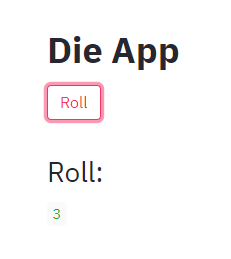Using Streamlit to build a dashboard¶
In this tutorial we will see how to create a service with a graphical interface using a very convenient python package called streamlit.
With streamlit it is very quick to make graphical applications and this can be used together with MVI to make dashboards for monitoring or configuration of your algorithms, just to name a few examples. We will not go into detail into how to use streamlit itself, but rather how to deploy a streamlit application in MVI and have it communicate with your services.
Creating the Streamlit Service¶
Let’s reuse the Die Roller service we created as part of the Yatzee game in Cross-service Communication and create a roll button and a display for the die roll. We start by creating a new project:
>>> mvi init
Active host: http://your-host
project_name [my_project]: die_app
The first thing we have to do is to add streamlit to the requirements.txt
file:
va-mvi
streamlit
We also rename service.py to die_app.py. This is where we will write our streamlit app, but in order for it to run when we start the service, we have to create a new file called app.sh with the contents:
streamlit run die_app.py
streamlit run script.py is the command that is used to start a streamlit app,
and we have to make MVI run that command when it starts the service. Normally MVI
runs service.py but this can be changed by modifying APP_SCRIPT in
.s2i/environment:
APP_SCRIPT = app.sh
This way we tell MVI that app.sh is the main file of the service and that it should be run on startup. The file app.sh must be executable to run properly, we fix this by adding yet another file, .s2i/bin/assemble:
#!/bin/bash
# Running stock assemble script
${STI_SCRIPTS_PATH}/assemble
# Making app.sh executable
chmod +x ${APP_ROOT}/src/app.sh
Now that all the boring stuff is out of the way, we can start writing the app in die_app.py
import streamlit as st
from mvi.communication import call_service
st.title("Die App")
roll = st.button("Roll")
if roll:
data = call_service(
service_name="die_roller",
entrypoint_name="roll_die"
)
st.header("Roll:")
st.write(data)
Deploying the Service¶
Since die_app is dependent of die_roller_service it has to be up and running before die_app can be used. The code for die_roller_service itself
import logging
from mvi import service
from random import randint
logger = logging.getLogger(__name__)
@service.entrypoint
def roll_die() -> int:
return randint(1, 6)
if __name__ == '__main__':
service.run()
>>> mvi deploy die_roller 1.0.0 ./die_roller_service
Active host: http://your-host
Deploying service...
Service deployed successfully
MAIN NAME VERSION STATUS RUNNING
------ ----------- --------- -------- -----------------------------------
* die_roller 1.0.0 running Running (since 2020-12-15 12:10:25)
We can now deploy the streamlit app, like we would any other, with one important difference. Streamlit uses internal port 8501 to communicate so we have to explicitly set the port when deploying:
>>> mvi deploy die_app 1.0.0 ./die_app --port 8501
Active host: http://your-host
Deploying service...
Service deployed successfully
MAIN NAME VERSION STATUS RUNNING
------ ------- --------- -------- -----------------------------------
* die_app 1.0.0 running Running (since 2020-12-15 12:15:35)
Note
MVI services created using the SDK use port 8000, which is the default
port for mvi deploy. But when deploying other apps it might be necessary
to change it to not get a Bad Gateway.
Open http://your-host/services/die_app/ and you should see your app there:
